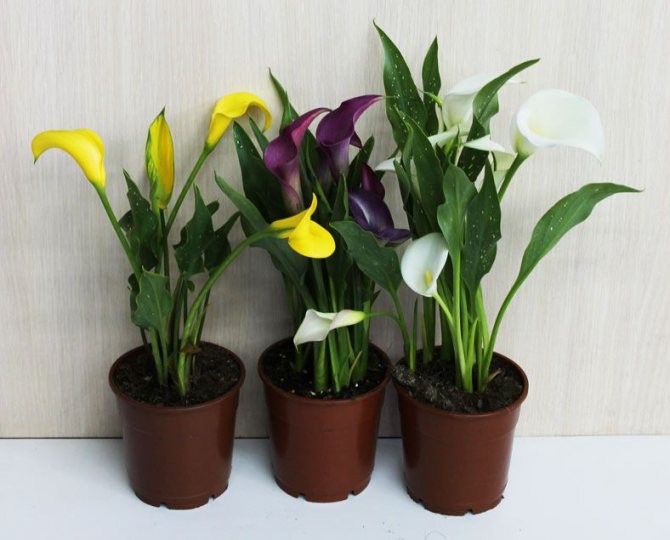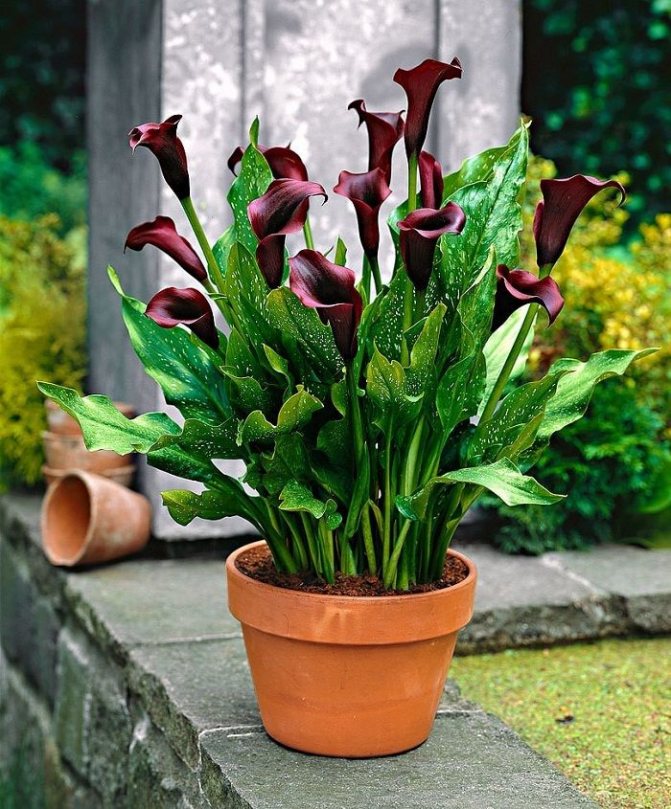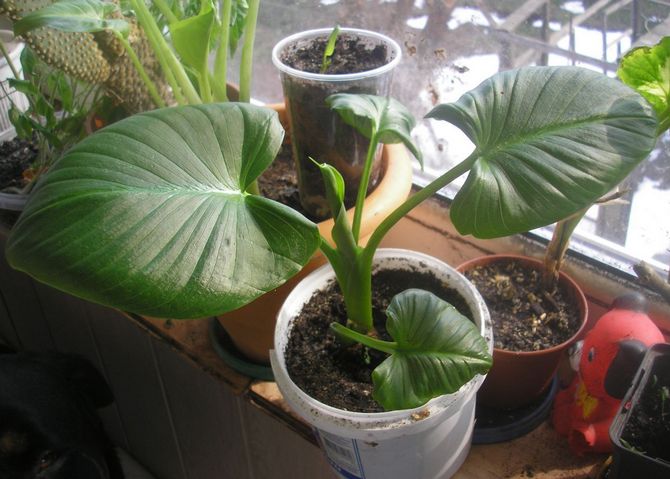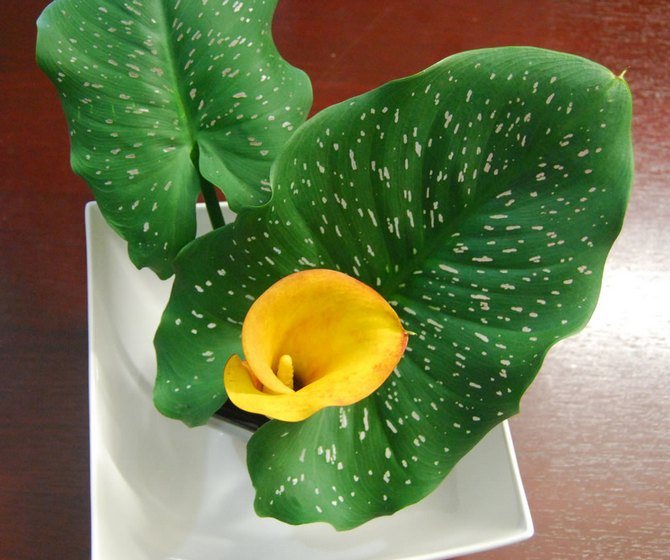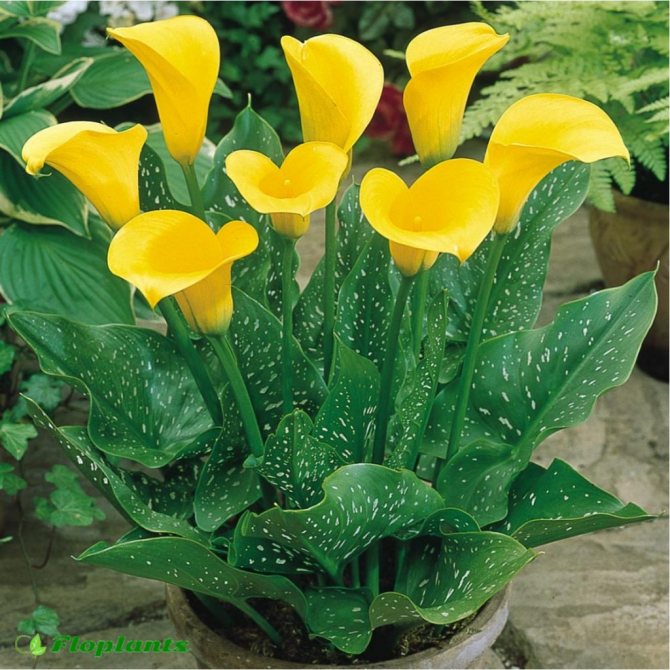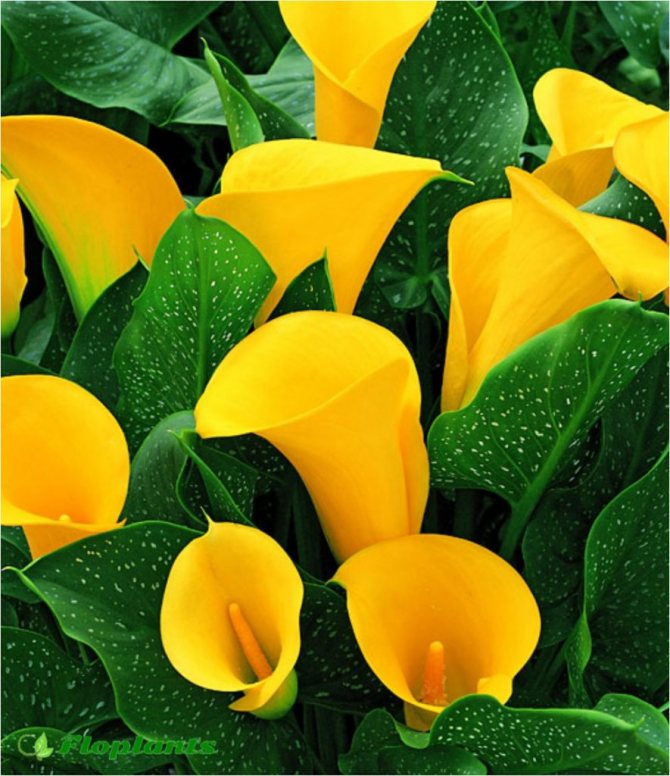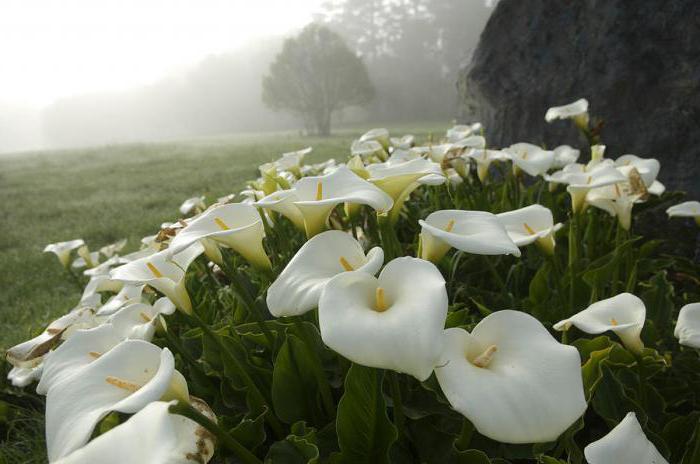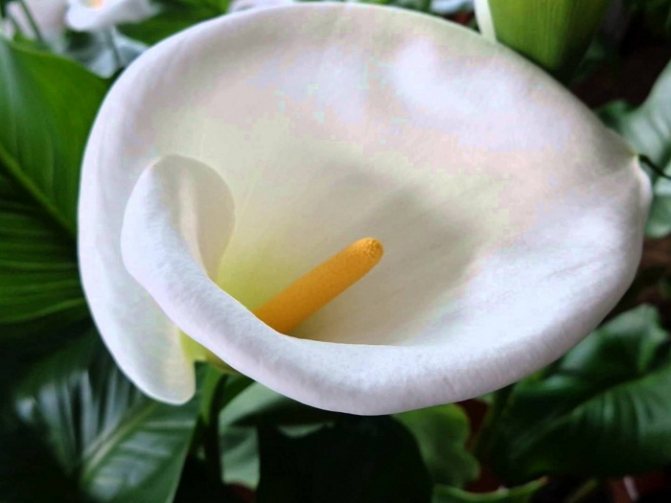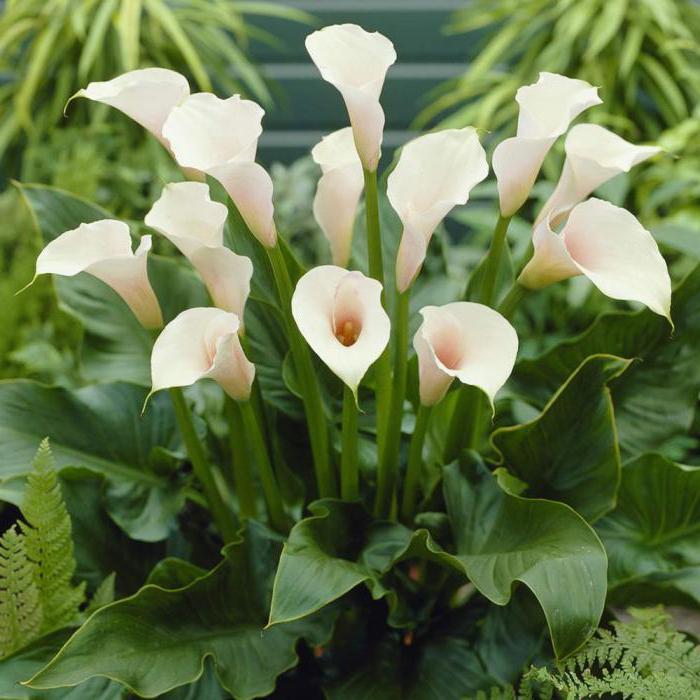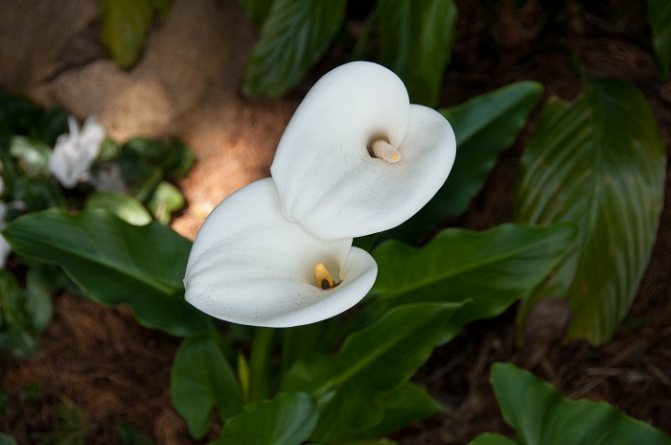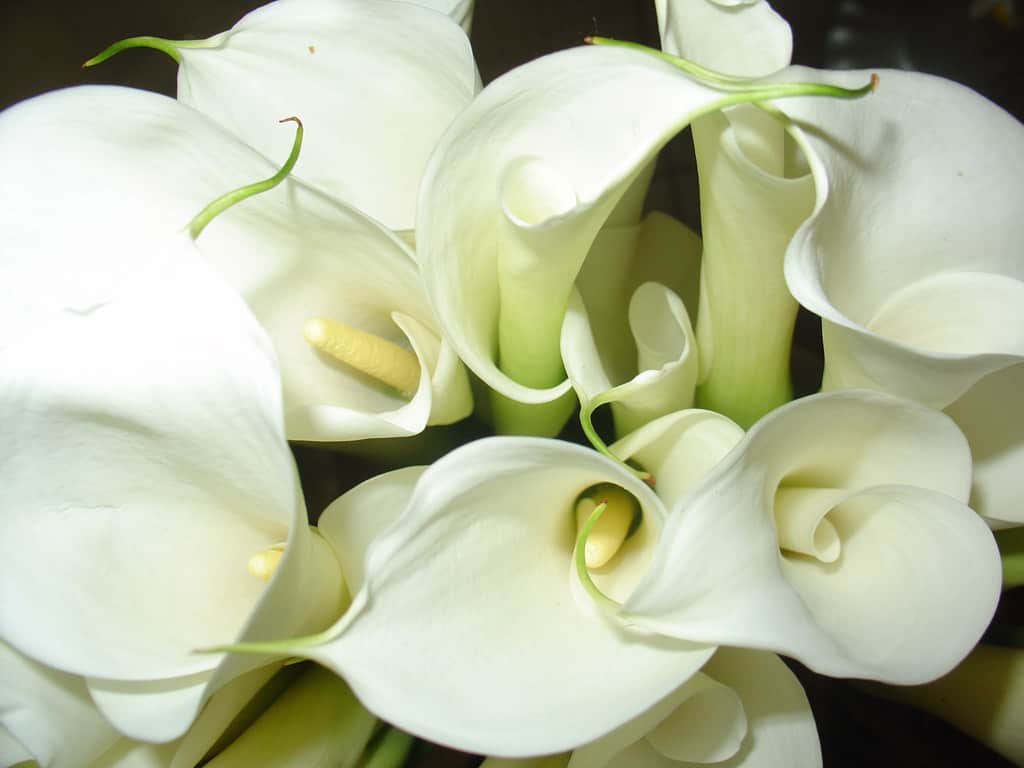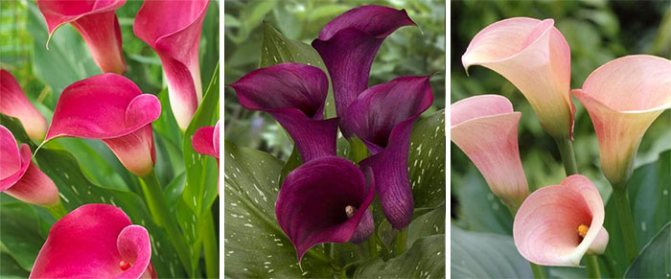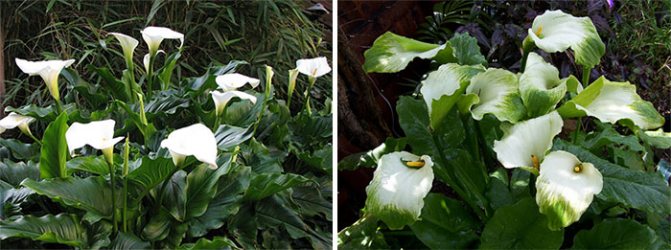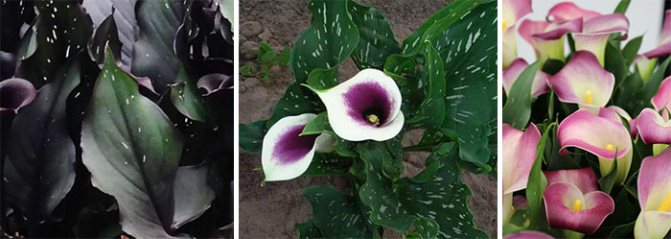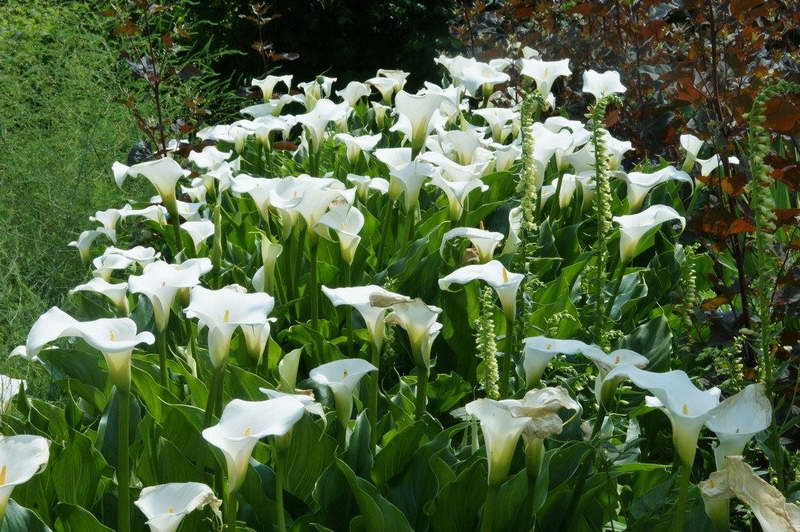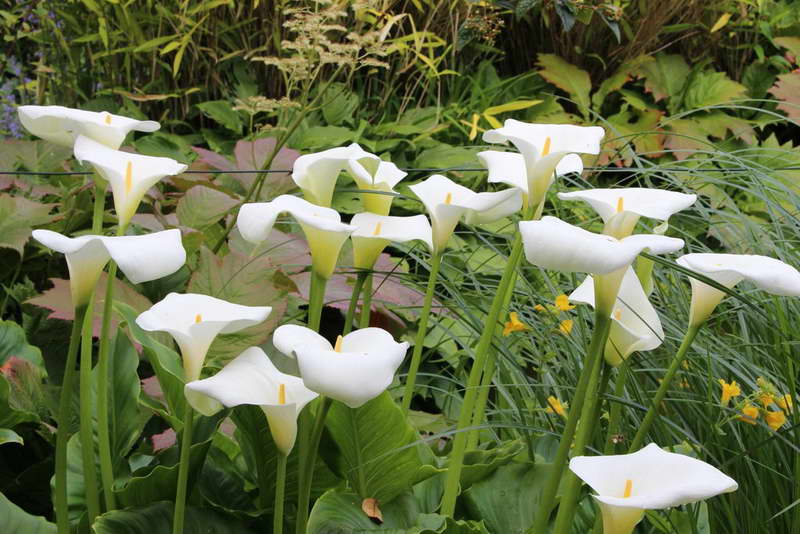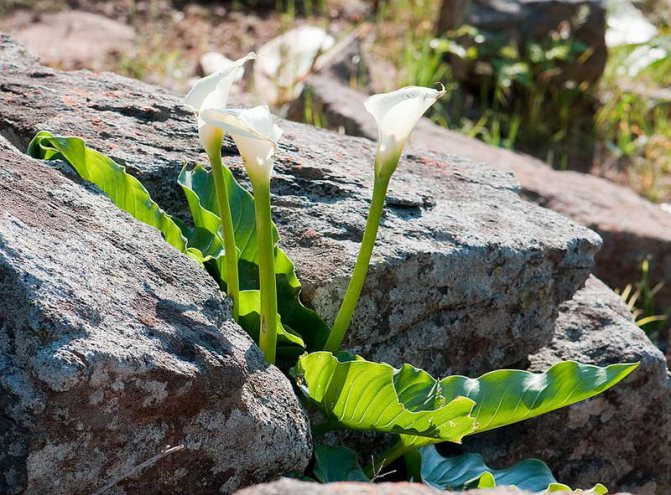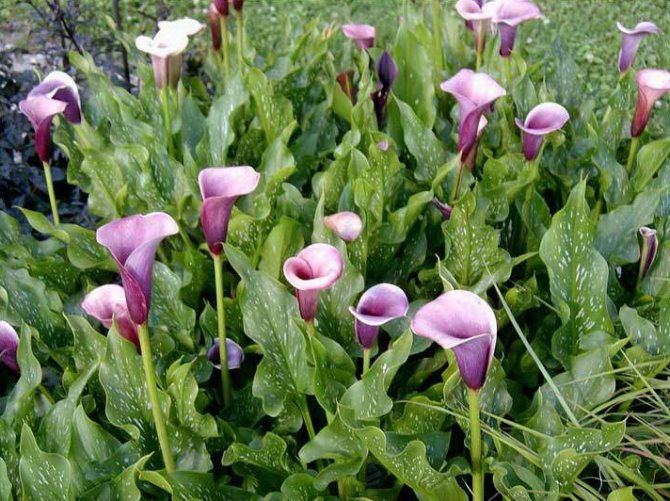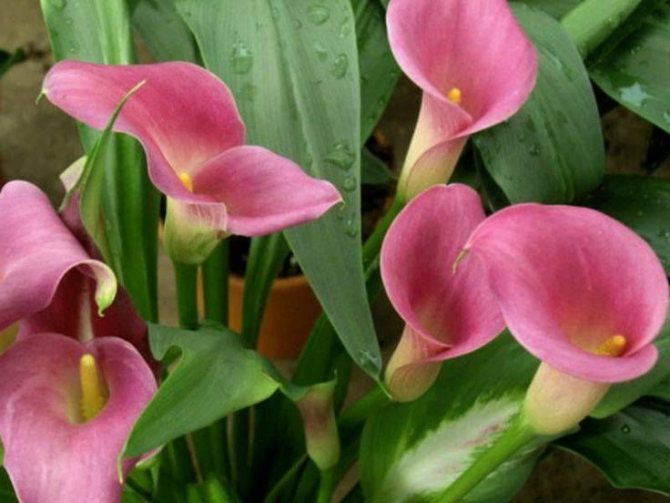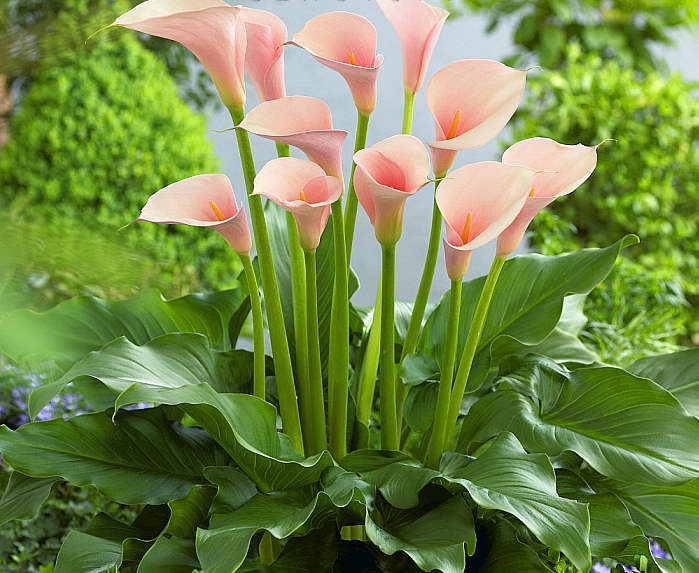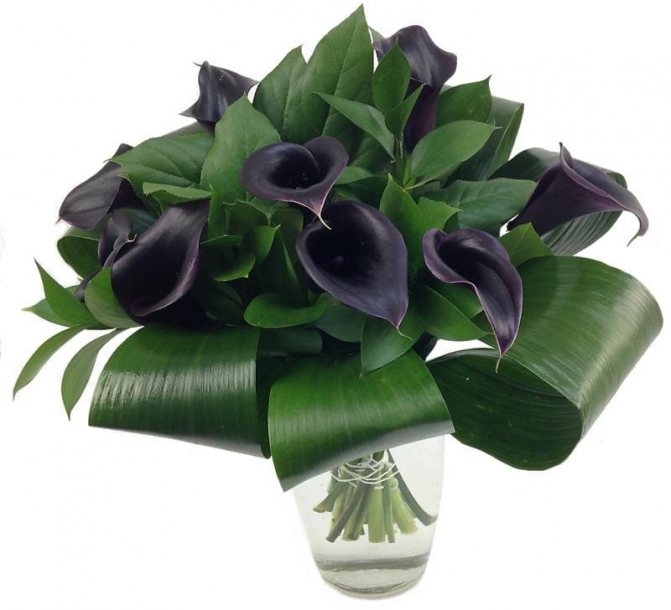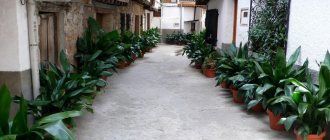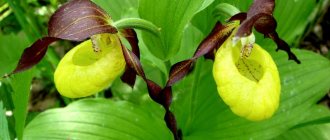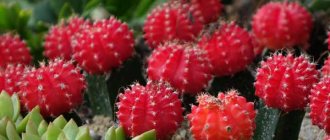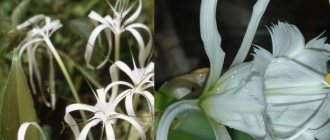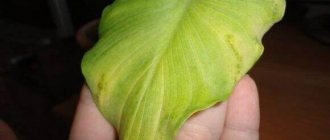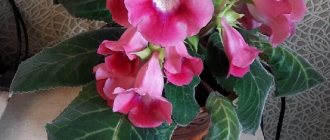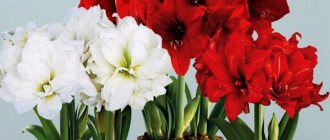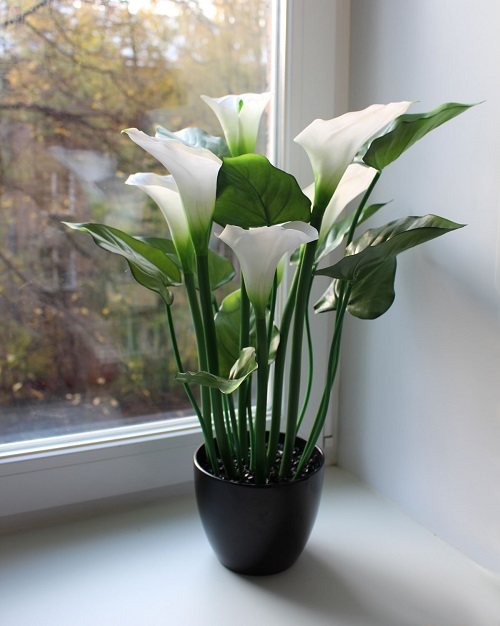
The strict beauty of calla is liked by many growers, but not everyone takes up its cultivation. Many believe that this indoor flower requires special attention. Of course, there are some special points, but in general calla lilies are easy to breed. Having created the right conditions for the flowers, you can grow a whole collection of beautiful large plants at home, which will annually delight you with their amazing inflorescences that appear closer to winter. And if there are too many of them, you can always make bouquets and give them to friends, because calla flowers remain fresh for more than one week after cutting.
Caring for Ethiopian calla lilies at home consists in performing a number of activities, namely:
- preparation of nutrient soil;
- choosing a suitable place for a flower;
- watering according to the phase of calla development;
- top dressing;
- annual transplant.
Calla lilies
The genus includes only 8 species, and only 3 are cultivated.
It is a white zantedeschia that drives out very tall flower-bearing stems. Unlike other species, it has a root, not a bulb.
it is a relatively low calla lily (about 65 cm) with a pink “flower”. The root system is represented by a tuber. In the fall, leaves fall from the flower and a period of calm ensues.
Also not very tall, reaching half a meter in height. This calla has both a flower and a veil around it of a bright yellow color.
It is a mixture of plants of a certain variety, the flowers of which will have different colors.
Options for how to propagate calla lilies
Experts say that reproduction of zantedeschia is best done by dividing the rhizomes after a dormant period in mid-July. However, at home, you can try other methods of breeding this plant.
, since it implies careful separation of small nodules from the central root. By the way, this essential material is sold in literally every flower stall. But you should pay attention to the fact that the purchased tuber must be grown before planting: the fact is that its size is not suitable for planting.
in this case, several shoots must be separated from the central stem and rooted in a nutritious soil mixture. Only after the seedlings have roots can they be transferred to other pots with pre-fertilized and drained soil.
Callas planting and care in the open field
This flower needs some amenities, so before planting, you need to learn how to care for the zantedeskia.
For growing in the garden, calla is planted in May. Before planting, the roots or tubers need to be examined and, if necessary, cleaned of rotten places, and the sections should be smeared with brilliant green, and they should also be dipped in a potassium permanganate solution for 30 minutes.
The planting site must be well dug up and fertilized with mineral fertilizing, the amount of fertilizer is about 30 grams per 1 m 2. Next, planting is carried out to a depth of no more than 10 cm, the distance between the bulbs is in the region of 40 cm. Water the soil with the planted zantedesky abundantly. There is no need to water for the next 15 days, the plants will have enough moisture after planting. Seedlings are likely to be slow - from two weeks to a month.
Watering adult plants should be moderate but constant.Fertilizers other than those applied before planting are not required. In the case of insufficiently acidic soil, watering with water with diluted vinegar or citric acid can be carried out.
The plant should be planted in a free, open area, but it is better that trees are planted nearby that can shelter the calla during the hot hours of the day.
How to water?
During active growth, calla lilies need regular watering to keep the soil moist, as well as spraying. With the onset of budding, the frequency of watering should be increased, but when the plant fades, gradually begin to reduce, bringing it to a minimum amount. This dormant period should last between 1.5 and 2 months.
It is normal for calla lilies to wither and shed their leaves at this time. So the plant gets rid of unnecessary deciduous parts in order to accumulate strength before future flowering.
Zantedeskia home care
In indoor conditions, caring for a home zantedesk is also not particularly difficult.
The flower is not very picky about temperature or humidity. The growing temperature in summer should be around 23 degrees. In winter, a decrease of up to 15 degrees can be allowed, but not lower. Zantedeskia does not like drafts, and it also needs to be protected from direct sunlight, but, nevertheless, it must be placed in a bright place.
In winter, if the calla is going to bloom, it needs to provide additional illumination, so that the daylight hours are 10 hours. Watering should be done carefully so as not to get water on the tuber, and in the interval between waterings, the earth should dry out.
Fertilization is carried out every fifth watering. For this you need to use liquid balanced dressings. The substrate for planting requires an acidic, about 6 ph, you can add sphagnum or peat to the soil.
To distill the plant, you need to take a tuber with a diameter of at least 5 cm and plant it in a pot with a diameter of 25 cm. The planting depth is 5 cm. After filling the tuber, the soil should be watered with diluted fungicide.
Post-flowering care for calla with roots and calla with tubers is different. Ethiopian zantedeschia, which has a rhizome, turns into a period of calm in the heat, its growth becomes slow, the leaves turn yellow. Watering during this period should be limited, and the flower should be placed in the open air, where there will be a lot of sun, but there will be no rain. In early July, zantedeschia is cleaned of dead leaves and offspring, and then transplanted, fertilization and watering begin.
Reproduction of zantedeschia
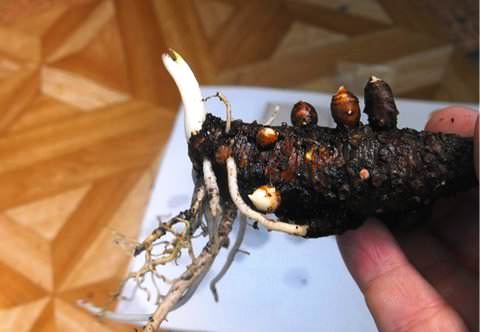

Rhizome of Ethiopian zantedexia with growth buds
It is better not to propagate zantedeschia seeds - this is a troublesome business, and the plant will bloom in the best case in 5 years. The vegetative method is much simpler - by offspring, dividing the rhizomes or tubers.
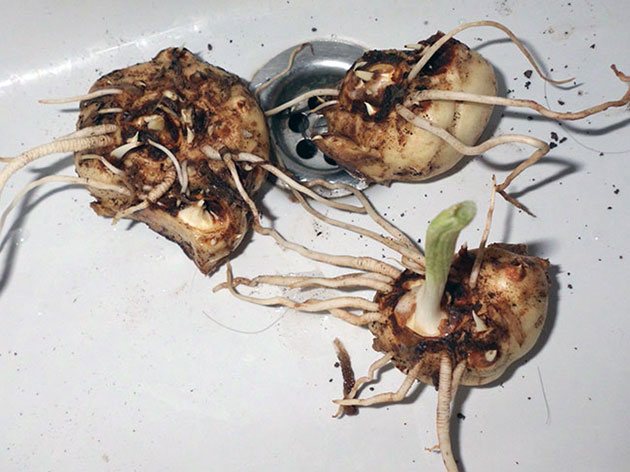

Zantedexia tubers
The offspring are separated from the main plant immediately after flowering and planted in pots to a depth of about 10 cm.Rhizomes and tubers are divided during transplantation, and experts advise not to cut them off, but break them with your hands, then grease the wound surface with brilliant green, sprinkle with crushed coal, give a couple of days lie in the shade and only then plant.
How to store calla lilies in winter
If your zantedeschia grows in a garden, then in September its roots will need to be dug up and kept together with a lump of soil in a dry, cool room, sometimes with a little watering. Zantedeschia with a tuberous rhizome begins to turn yellow and dry after flowering.
In the garden, such calla is kept until the last week of September, and then carefully dug up, the tubers are washed and dried. For two weeks the plants are kept at a temperature of about 8 degrees, during which time the roots absorb nutrients from the stem and leaves. Then the dead top of the flower is removed.
Before storage, tubers should be kept in a solution of potassium permanganate for half an hour, rinsed and dried again. Storage should be carried out at a temperature of 6 degrees.Do not put the bulbs in plastic bags as they need to breathe.
If it is not possible to store the root calla as a tuberous calla, then the roots are slightly dried and stored as bulbs. When growing zantedeschia in a pot, you can leave it on for the winter, but watering must be stopped.
Features of agricultural technology of the Ethiopian calla lily
The dormant period begins immediately after flowering. Therefore, it is necessary to maintain a temperature of 18-20 degrees. Below 160 C, the flower can get sick. During the dormant period, watering is carried out only to maintain the remaining moisture in the soil for 1.5 - 2 months. At this time, part of the leaves dries out. But it is important to prepare the plant for dormancy gradually, reducing the intake of moisture, and they also bring the flower out of hibernation.
The humid air will help keep the calla lily leaves beautiful. Therefore, they are sprayed, bathed in the shower. A humidifier, a tray with pebbles and moss, an aquarium will delight the plant.


The exotic name "Zantedeschia" hides the well-known calla lilies. This is a plant from the Aroid family, a relative of anthurium, spathiphyllum, monstera and the nondescript marsh plant calla.
Reliable tubers
In nature, zantedeschia grow on moist swampy soil, therefore, when compiling a soil mixture for planting, river silt is added to it if possible (up to the entire volume). In addition, the trays for the pots should be deep enough to hold a 5-7 cm layer of water.
As a rule, flower shops sell blooming zantedeschia in pots, as well as tubers, which can be found on sale from January to April. From them, as a rule, healthy and durable plants grow. The acquired tubers should be firm, with live apical buds and fresh yellowish skin free from mold stains and damage. Until March, planting material is stored in a cool place, sprinkled with peat or sawdust.
Zantedeschia
Diseases and pests
- Among the diseases of zantedeschia, the flower most often affects rot.
- Gray rot most often appears from the soil or diseased neighboring flowers, and bulbs can also be diseased.
- To destroy brown rot, you need to stop watering the calla and reduce the temperature, it is advisable to remove the moist topsoil and replace it with a dry one.
- Aphids can also be damaged, in this case, you can simply wash the flower with soap or use special preparations.
- If you do not have zantedeschia blooming, then the reason may be watering during the dormant period, or you just have a young plant and you need to wait a year or two. Also, flowering is absent with an excess of nitrogen fertilizers.
Calla is considered a real royal flower, symbolizing tranquility, respect and beauty. Home care for this plant is simple, but you should know some of its features so that the flowers are not crushed and retain their brightness.
Growing conditions
The flower prefers to be in the shade, where the sun can appear in the evening. The pot should have spacious parameters, preferably above 60 cm and a diameter of 20 cm. If feeding is carried out on time, the plant will grow faster. To do this, you can make a small groove along the edge of the pot and pour the existing organic matter into it, for example, peel from fruits: apples, bananas, kiwi, seed husks, tea leaves. Sprinkle the organic matter with a substrate and water it well with mineral fertilizers dissolved in water.
Calla lilies feel best in a spacious and bright room. Under conditions as close as possible to natural, the plant will delight with its beauty for a long time. The container for these flowers needs a voluminous one, with a sufficiently deep pallet. Ethiopian calla is not afraid of the sun's rays, but it must be protected from drafts. It is very important to comply with the basic rules of cultivation - maintaining the required temperature, lighting, humidity, timely feeding.
Description of the plant
At the first sign of root rot, watering is stopped or the soil is replaced with a less moist one. To get rid of gray rot, as well as anthracnose, which is characterized by the appearance of brown spots on the leaves, the plant must be treated with fungicides.
There is no cure for bacterial rot, which the calla flower is susceptible to. Home care must necessarily include preventive measures to prevent the occurrence of this serious disease. They consist in carrying out the processing of tubers for the purpose of disinfection. If the plant already shows signs of bacterial rot (darkening of peduncles, leaves and roots), all affected parts must be removed immediately. With a significant lesion, you have to dispose of the flower completely.
Among insect pests, the most dangerous for calla lilies are aphids and spider mites, a sign of the appearance of which are small blotches on the leaves of a yellowish color. To combat the tick, such drugs as Fitoverm, Vertimek, etc. are suitable. What kind of products are best used should be clarified when purchasing a calla flower (mix), care at home for which will definitely require protection of this plant from insects- pests. Against aphids, spraying the flower with a solution of laundry soap is enough.
When to dig up calla lilies and how to store them in winter (with video)
According to experts, knowing what conditions are necessary for normal growth and development of calla lilies, caring for and taking care of room calla can be a real pleasure.
- Location: bright sunny or semi-shady, in the summer to be exposed to the street.
- Temperature: warm in summer, cool in winter (about 10 ° C).
- Substrate: flower soil mixture.
- Watering: after flowering from the end of May, keep completely dry for 2 months, then shake out the clod, plant again and slowly increase the watering rate. Water abundantly in winter and spring.
Regardless of the fact that the process of caring for and growing a calla flower will take place at home, experienced craftsmen remind you to follow the rules of agricultural technology that are intended for garden specimens.
- It should be remembered that this plant does not emerge immediately after planting, since it takes time to form its root system. Therefore, there is no need to worry: you just have to wait a little - about 30-40 days.
- In addition, even an unpretentious indoor calla plant should be carefully subjected to the planting procedure: we are talking about sprinkling its roots with soil quite a bit so that it does not rot in the future.
if there are drops of water on its leaves, it means it will rain.
instead, it is necessary, in turn, to add a nutrient substrate.
Moreover, this process must be carried out according to the rules, since zantedeschia can get sick.
it is very important that the flower pot is porous. This is necessary, first of all, so that excess moisture does not accumulate. Moreover, do not plant other specimens together with calla - it does not tolerate neighbors.
to grow it like this, you need to know the advice of experts on what to do with calla before the onset of winter cold weather.
Only then can the plant be sent for storage in a dark, always dry place, having previously packed it in a paper bag. It should be noted that the temperature in the selected room should not be lower than 7 ºC. There is another reliable way of how you can safely store calla at home in winter: for this, you need to dry the rhizomes of the flower slightly, completely get rid of the leaves, and then, after processing with a solution of potassium permanganate, place it in any suitable place. In this case, you just need to remember to periodically check the perennial so that it does not dry out or rot.
On a note
Despite its amazing beauty, calla is a poisonous flower.Once inside the body, it can cause intoxication, vomiting. Therefore, it is worth placing this plant away from children to avoid possible accidents.
Nothing difficult for such a plant as calla, home care. The photos of these elegant, sophisticated flowers, posted in the article, demonstrate what beauty can be grown on your windowsill with a minimum of effort.
Calla Ethiopian is a very elegant ornamental flowering plant. Its distinctive feature is that it is not the flowers of the plant themselves that attract attention and cause admiration, they are small, yellowish, inconspicuous, collected on the cob, but a snow-white funnel-shaped collar enveloping them.
The amazing flower can be grown at home in a pot or in an outdoor garden. Cut Ethiopian calla lasts 10-14 days, so florists like to use it in bouquets.
Calla Ethiopia is the commercial name for the perennial herb Zantedeschia aethiopica, belonging to the genus Zantedeschia, of the Araceae family. The flower is also called Calla and Aronnik.
The native land of the Ethiopian Calla is South Africa, where the flower grows mainly in swampy places. In nature, there are specimens of Zantedeschia 2.5 m high.It usually grows up to 1 m when cut in the garden or at home.
The leaves of the plant are radical, they are collected in an outlet. The shape of the leaf plate is heart-shaped, the color is green. The sheet can be up to 50 cm long and up to 20 cm wide.
Inflorescences of miniature yellow flowers are 10 cm long. They are formed on a long peduncle, towering over a rosette of leaves. The inflorescence is wrapped in an inflorescence funnel-shaped blanket. Usually this bedspread is painted in a snow-white color (that's why the flower is called Calla lily), but in some varieties of Ethiopian Calla it is yellow or pink. Flowering occurs from November to May. If the flower is properly cared for at home, it will bloom annually.
Home-grown Ethiopian Zantedeschia is odorless and has a delicate sweet scent from garden flowers grown in the sun.
Numerous varieties of Calla Ethiopian differ in height, leaf size and bedspread color. As a home decoration, garden plot, as well as in floristry, the following are most often used:
- "White Seil" - white, wide bedspread;
- "Green Godness" - the blanket is white inside and green along the elongated part;
- "Pink Mist" - pink bedspread;
- "Red Disser" - a white blanket and red flowers collected in inflorescences.
general description
The height of the zantedeschia ranges from one to two and a half meters, depending on the species. The root can be a powerful branched rhizome or a fragile tuber. The leaves of the plant are heart-shaped, with a glossy surface, up to 40 cm long and 20 cm wide, on long fleshy petioles.
The zantedeschia flower is a yellow ear-inflorescence on a long arrow. The bract bed is large, funnel-like, white, yellow or pink in color. After pollination has occurred, the color of the bracts changes to green.
How to grow Ethiopian Calla
Despite the exoticism and external fragility, Zantedeschia is not a whimsical plant. It is not difficult to grow it.


Caring for Zantedesk Ethiopian at home involves an annual transplant. The plant is transplanted shallowly into the soil with humus and peat. The initial temperature for a transplanted flower is about 10 ° C, then it is increased by 5 degrees.
Many are interested in the reproduction of calla lilies. This can be done by seed or vegetatively, which is more convenient.
Seed reproduction is important for the mass cultivation of flowers.Freshly harvested seeds germinate in boxes on shelves in the warmth (20-25 ° C). They dive in one and a half to two months. Young plants planted in turf, peat, sand and leafy soil (1 part each) are kept at a temperature of 15-18 ° C and watered abundantly. After a year, they are transplanted into larger pots.
Around the maternal shoot of an adult zantedeschia, shoots are formed, which are used for vegetative propagation in early summer, when the plant is in a dormant period. Shoots with 1-2 roots are planted in a bowl with a diameter of 8-10 cm. The composition of the substrate is turf (2 parts), leafy soil, peat and sand (1 part each).
During the first week, they need abundant watering, which is done several times a day, and regular feeding. By the end of summer, they should be firmly rooted, and after that they can be transplanted into a greenhouse or large pots.
Domestic calla lilies are susceptible to pest attacks. If a spider mite, aphid or scale insect is found on it, it must be treated with an insecticide.
The elegant Ethiopian calla is a poisonous plant. Its juice, if it comes into contact with the skin, can cause irritation, and if ingested, it can cause swelling of the mucous membrane of the throat and larynx, food poisoning with vomiting and diarrhea. When caring for her, you must observe safety measures.
Competently organized care of the zantedesk is a guarantee of the health and beauty of the flower. It will delight the eye, growing on the ground or in a pot, and cut off - in a bouquet. Photos often show the design options for bouquets with calla lilies.
Today we will talk about a popular flowering plant that came to us from South Africa. It will be about the nuances of cultivating at home and wintering Ethiopian calla lilies. If you call this plant universal, then you will be one hundred percent right. They are used to decorate dwellings, include in bouquets. This is an excellent greenhouse plant.
Content:
Several features of the Ethiopian calla lily:
- Big sizes.
- Wide, succulent, shiny leaves.
- Heart-shaped bright green leaves.
- The original structure of the flower is an inflorescence-ear on the arrow.
- The beginning of flowering is the second half of the winter period.
- The plant pleases the eye with magnificent flowers for one and a half to two months.
So, let's move on to the main questions.
What does an overseas calla flower look like?
It should also be noted that now the flower is very popular with many gardening masters precisely because it can be easily grown both at home and on the street. In addition, due to how stunning the calla flower looks like - a combination of spectacular large leaves, bright inflorescences on long petioles and a funnel-shaped bract - most connoisseurs choose this plant as a decoration for their home. By the way, the foliage of this representative of the flora visually resembles the most real arrowheads with beautiful silver splashes!
in Europe it is associated with the embodiment of devotion and tenderness, and brides prefer to use it to compose charming wedding bouquets. Despite this, growing an indoor calla flower overseas, every gardener should remember that this plant is capable of producing poison. That is why, when choosing a place for your "pet", you must try to place it where children or animals cannot reach it.
poisoned juice is skillfully used as an antidote against snake bites.
This is due to the fact that this overseas specimen is characterized by low germination, as a result of which the sprouts of zantedesia do not always break through, even among gardening professionals.
Despite this, there are a few tips to keep in mind that can make the breeding process easier. Firstly, before placing the seeds in the soil, it is imperative to soak them in a growth-stimulating solution for about 6 hours. After that, you need to pull them out and lay them on an ordinary, slightly damp cloth in a warm and dry place.You need to store the seeds in this form for 7 days.
As soon as the zantedeschia has found its place, you should control the process of watering it: the amount of water should not be large so that the seeds do not rot. But in order for the perennial to receive the necessary moisture, you need to carefully feed it through a small hole in the bottom of the pot - that is, using a pan with water under it.
It must be said right away that the cause of all calla lilies' misfortunes is fungal diseases. However, insects, such as spider mites, along with aphids, periodically bother this flower. Most often, bacteria and all kinds of pests are attacked by those specimens that suffer from improper care of the gardener or an absolute neglect on his part.
- Watch the soil in the pot: it should not be allowed to dry out, or vice versa - it was too flooded with water.
- Do not leave the plant in direct sunlight.
- It is necessary to beware of drafts, which are often the cause of numerous troubles.
Among the most common diseases of indoor calla flowers, experts distinguish the following - anthracnose, bacterial, gray and root rot. First of all, it is necessary to remember that the brown spots covering the foliage of the perennial will be a signal that the calla has been affected by anthracnose. But that's not all: these lesions will then begin to crack, and the plant itself will dry out.
: as soon as they notice a grayish bloom on certain areas - leaves, stems, inflorescences - they use means such as, for example, "Rovral" (fungicide). In addition, experienced craftsmen say that the cause of the defeat can be either excessive humidity in the room, or in the soil itself. That is why you should not forget to ventilate the room and carefully monitor the irrigation process.
It is because of her that they begin to slowly fade, and when the already dead flower is removed, it becomes clear that the roots themselves were affected, which were completely covered with a fungal bloom. To prevent such an incident, you need to monitor how abundantly watering is done. It is the waterlogged soil that causes this disease.
Quite often, people wonder how to make an overseas calla plant bloom at home. However, they do not think about what was the reason that their indoor "pet" is not covered with lush color.
- Frequent movements from pot to pot and the very movement of the container around the apartment have a very negative effect on the calla.
- Not conducive to flowering and lack of sufficient fertilizer and lack of sunlight.
- Lack of control over the growing tubers also leads to a weakening of the zantedeschia.
By the way, it is also necessary to know about these perennials that they tend to shed their leaves. That is, there is no need to think that the flower has died - it is just in this way prepared for a period of rest.
A few words about the varieties of calla lilies
There are varieties of calla lilies in which flowers (more precisely, a flower bedspread) are not white, but colored. However, they do not come from the Ethiopian calla, but often from the yellow-flowering Elliot calla and the Reman calla, in which the initially pink flowers later turn purple-violet.
These species do not have roots, like Ethiopian calla lilies, but tubers. They are planted in February. Plants develop relatively quickly and bloom after 60 days. Recently, the tubers of these unusual calla lilies can be bought in specialized stores.
These varieties usually bloom during the summer. Calla lilies fade in autumn, their tubers are taken out of the ground, dried and stored for two or two and a half months at a temperature of 12-15 degrees, then planted again in the ground.
Did you know! Calla Ethiopian used to have the botanical name "Salla"? Later this name changed, and this genus of plants was named after the physicist F.Zantedeshi (1773-1846) - "Zantedeschia". There was a time when this plant was called "ricardia".
Zantedeschia: growing and care
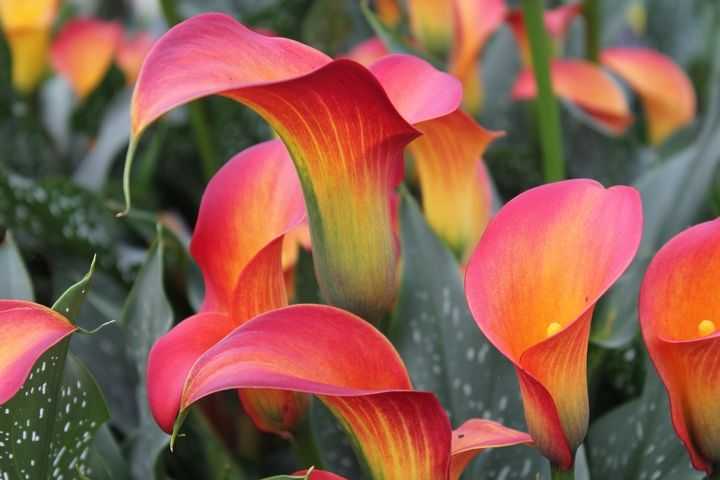

Usually, only Ethiopian calla (Calla aethiopica) is well known to flower growers. Recently, however, other calla lilies have been constantly on sale, which, unlike their Ethiopian relative, have not only a pure white coverlet, but flowers of simply mesmerizing, extraordinary colors and color combinations! Many varieties of calla lilies Remani (Calla rehmanii) and Elliott (Calla elliottiana) amaze with unusual flowers, the range of which includes literally all colors and combinations of colors: from pure white to almost black. Colored calla lilies are white and pink-white, mango-orange and orange-red, lilac-shimmery and lemon yellow. The palette of colors is diversified by strokes, borders, specks and gentle transitions from one color to another. Truly, tuberous calla lilies are simply extraordinary, bewitchingly beautiful! The varieties derived from the Remani calla have narrower and more solid green leaves, while the Eliott calla has silvery dots on the leaves, which gives the plants an extra charm. Having grown this extremely effective and easy-to-care flower once, you will want to return to it again and again, replenishing the collection with all the new varieties. However, let's first figure out what a tropical guest loves.
Our beautiful calla belongs to the aroid family. Throughout the history of the cultivation of this flower, it was repeatedly renamed, including on sites for florists, it was called either Calla (Calla), then Richardia (Richardia), then Zantedeschia (Zantedeschia). Today the plant is called both calla lilies and zantedeskia, however, calla lilies are still more called Ethiopian calla lilies, and colored calla lilies are usually called zantedeskia.
The spectacular "flower" of calla lilies is a cover leaf (bedspread) in which the very yellow inflorescence-ear itself is wrapped, consisting of many small and nondescript, but extremely fragrant flowers. Their delicate aroma is a bit like vanilla. The height of colored zantedeschia usually does not exceed 50 cm, while the Ethiopian calla is much larger - its leaves and flowers rise to a height of one and a half meters! However, the exquisite beauty of zantedeschia more than pays for their small size, which other gardeners who do not have large plots undoubtedly rank among the merits. Indeed, even a small area can accommodate a whole collection of these magnificent plants!
Instead of the powerful underground rhizome that the Ethiopian calla is supplied with, zantedeschia have flat tubers, which grow in width with age, and take the form of flat cakes with many growth buds. The larger this "cake", the more powerful the bush will be, and the more flowers it will be able to produce per season. Calla Ethiopian is very demanding on soil and air moisture, and zantedeschia, although they love moist soil, can tolerate periods of short-term drought, and are almost completely undemanding to air humidity. Neither the flowers nor the tips of the leaves dry out, even during the hot and dry summer months such as July and August. Moreover, if Ethiopian calla lilies cannot be destroyed by any amount of water, then zantedeschia, or tuberous calla lilies when grown in containers from excess moisture can simply die!
When should you buy and plant tuberous calla lilies? First of all, you should know that the larger the tuber, the more likely it will bloom in the year of planting. You should not buy shriveled and dry tubers - a high-quality zantedeschia tuber should be dense and elastic. However, having purchased planting material in February or March, do not rush to plant it immediately - of course, if you want to plant zantedeschia in the garden. But even with containerized plant maintenance, it is still better to wait for sunny and warm April days.And before planting, you can keep the tuber in a bag with slightly moistened peat or sawdust in the refrigerator, on the veranda or in the cellar. In April, when the day will noticeably increase, and the night frosts are weakening, it is time to wake up the zantedeskia tubers. Before landing in the open ground, zantedeschia need to provide sufficient lighting and a difference between day and night temperatures. Then the aerial part of the plant will form correctly - the leaf petioles will be short, resilient and thick. To do this, you can put a pot with a sprouting tuber on a closed balcony, veranda or in a greenhouse. Before planting zantedeschia in the garden, they can be grown in pots, and in April-May they can be taken out to a greenhouse for vegetables and flowers, where they feel great. When the threat of frost blowjob, our beauties can be carefully transferred into the open ground. The volume of the pot in which the tubers germinate should be minimal so that they fit well in it, and nothing more. Like all bulbous and corms, zantedeschia are very fond of "eating", so the soil mixture should be fertile enough. Zantedeskians prefer slightly acidic soil, and a mixture of peat, humus, leafy earth and sand in a ratio of 1: 1: 1: 0.5 is well suited for planting. Tubers are planted shallowly - lay them on the surface of the substrate and sprinkle with a thin layer of soil - no more than two to three centimeters. Tuberous calla lilies are watered abundantly, but only after the soil dries up.
When planting in open ground, the planting hole is filled with a fertile mixture - this is done if the land on the garden plot is sandy or sandy loam. In those regions where there are prolonged droughts, when planting, it is necessary to add to each plant from 100 to 200 g of pre-soaked silica gel - it helps to retain moisture at the plant's root system, and to obtain large tubers with full growth in autumn.
In a garden for Zantedeskis, it is best to set aside a place in partial shade, preferably with some morning or evening sun. Tuberous calla lilies feel good next to a pond, which provides them with the moisture necessary for a comfortable existence. Another secret of successful cultivation of Zantedeskiy is watering with acidified water. Battery acid is best used for acidification. A tablespoon of acid is diluted in a bucket of water and this solution of calla is "treated" three to four times per season.
In the open field, zantedeschia bloom from early June to autumn. The flowers, without losing their decorative effect, stay on the plant for a very long time - up to one and a half months and longer, but when the flower cover begins to turn green, it is better to remove the flower, since the greening of the cover serves as a signal that the zantedeschia has set the seeds. Usually, seed propagation of Zantedek is necessary only for breeders, and it is more expedient to cut the ovaries in the flower garden. Removing the seed ovary will promote the growth of the tuber and the formation of new children on it. For good health and abundant flowering, zantedeschia require regular feeding - about once a week. You can feed it with both organic fertilizers (mullein, chicken droppings, fermented grass) and complex mineral fertilizers. For the fastest assimilation, all fertilizers are applied in liquid form, along with irrigation.
Before the start of frost, the Zantedean is dug out of the ground to be sent to rest. In order for the tubers to receive the maximum nutrients from the leaves, it is not necessary to cut off the leaves, but, shaking off the soil from the roots and re-labeling the varieties, put the calla lilies in plastic boxes and put them in a bright, cool and dry room. They stay there for about two weeks. Yellowed and withered leaves are easily removed, dry soil also crumbles easily. Zantedesky roots must be carefully trimmed - they themselves do not dry out and do not fall off like leaves.Thus, after two weeks of drying, clean tubers that have accumulated a large amount of nutrients are laid for storage. Zantedesky tubers are juicy and rather fragile, and if handled carelessly, they often break in places where the baby grows. Since the juicy pulp of the tuber is prone to decay, the places of the breaks must be treated with brilliant green, dried for three to four days, and only after that they must be stored.
If there is not much planting material, then Zantedese is best preserved in the vegetable compartment of the refrigerator. Also, tubers lie well in a dry cellar, or on a warmed veranda, at a temperature of + 3 ... 5 ° C. At a higher temperature, it is undesirable to store Zantedesky, as they germinate quickly. Calla lilies that have sprouted at the wrong time will have to be planted in a container and provided with additional lighting - otherwise their leaves will stretch out. When growing, you also need to take into account the factor that without a full dormant period, your beauties will not bloom.
You can store tubers in slightly damp peat or dry sawdust. Sometimes during storage from excessive dampness or as a result of infection, the tubers rot. In order to avoid losses, it is necessary to check the tubers several times during the winter, and, if necessary, clean up the tissues that have rotted to healthy, cover up the damaged areas with green paint and dry them. You can also process and sprinkle the Zantedez tubers with chopped charcoal, best of all birch. It simultaneously dries tubers and disinfects small wounds.
Divide the tuberous calla lilies a few days before planting, if necessary, separating the baby or carefully cutting the tuber into several parts. Do not get too carried away with dividing - large tubers with many growth buds give the most flowers. A small baby, separated from the maternal tuber prematurely, will grow too long before flowering, and growing up with the maternal tuber, it can increase two to three times over the same period.
Wintering conditions
Calla Ethiopian is a plant with pronounced growth cycles. Usually, it begins to bloom under favorable conditions already on the eve of Christmas. The flowers then last until summer.
Then a dormant period begins, which is indicated by the yellow leaves. Watering is now limited and then paused completely. The plant pot can now be moved to a protected location on the balcony or garden. The earth can even dry out completely. There is usually enough natural rainfall to keep the tuber in the substrate from drying out completely. On the balcony, you need to lightly water the plant from time to time.
After a dormant period, after about 4-6 weeks, the knobby tuber is removed from the pot, the earth is shaken off and planted in fresh soil. A heavy mixture is suitable for planting. If using ordinary flower soil, you can mix in a small amount of compost or clay. Mixed soil is also suitable. At first, the tuber is kept moderately moist. However, as soon as shoots begin to appear, the plant is watered more abundantly and fertilized from time to time. The plant needs a relatively large amount of nutrients.
If calla lilies are still in the open air in the fall, before the start of frost, they are rearranged into the room and kept at a temperature of 9 degrees. Later, the temperature can be increased to 14 degrees. It is very important at this time that the plant is in a bright place. Calla tolerates small portions of the sun well. Under favorable conditions, calla lilies begin to bloom again by the end of winter or in spring.
Calla lilies requirements for room maintenance
In order to grow zantedeschia, as in the photo, you need to create natural conditions for it. In summer, the plant thrives in the garden in the sun from the windward side. Zantedeskia is not afraid of the sun's rays, but she is afraid of drafts. On the window, the plant needs full illumination in the season with a short day. Lighting should be 12-14 hours.On the south window, the zantedeschia needs to be shaded from the midday sun. The temperature in summer is 20-23 degrees, in winter about 13 for a flower will be just right.
Better than other varieties, Zantedeskia Ethiopian feels on the windowsill. The flower-ear is covered with a long bracts. This species blooms at the end of winter, and pleases with its beauty for more than a month.
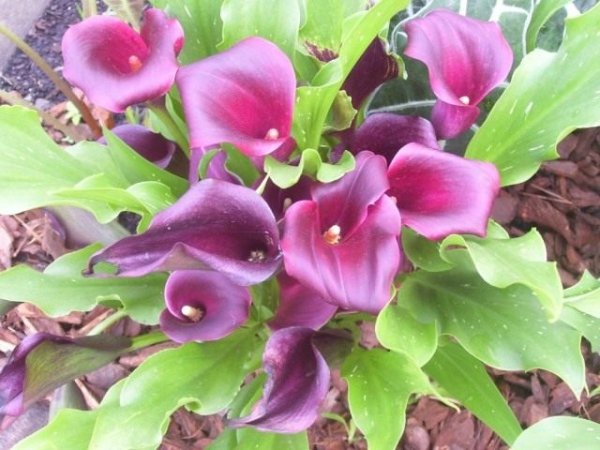

On the shelves of flower shops you can see modern varieties of Zantedeschia, which amaze with their amazing beauty and grace: tall (up to 1.5 meters) plants with white flowers, obtained from Ethiopian Zantedeschia (Zantedeschia aethiopica), and not tall (up to 50 cm) forms with pleasantly scented flowers of various colors, descendants of Zantedeschia Elliotti (Zantedeschia Elliottiana), which has golden yellow flowers, and Zantedeschia rehmannii (Zantedeschia rehmannii), with a pink-red color of flowers.
South Africa is considered the birthplace of these callas. Magnificent flowers are a real decoration of apartments, greenhouses, look great in bouquets. The plant is large, with broad, succulent and shiny leaves, heart-shaped and bright green in color. They are located on long basal petioles and collected in rosettes. The flower itself is distinguished by its original structure. It forms at the end of a towering arrow and is a yellow ear-shaped inflorescence wrapped in a white blanket. Its smell is very faint and resembles vanilla.
Flowering usually begins in the second half of winter and lasts for 1.5–2 months. Ethiopian calla is known under different names - zantedeskia, richardia, calla. The tuberous rhizome forms numerous offshoots each year, which must be removed so that they do not delay flowering.
At the end of flowering, the growth of calla lilies stops, but the roots continue to develop. This period usually lasts from May to July. Until autumn, the plant can be placed on a balcony or loggia, where piercing winds do not penetrate and there is an opportunity to shelter from the sun. Neither watering nor feeding is done at this time.
Calla lilies can be put into a state of deep dormancy by removing the leaves completely and placing them in a refrigerator, cellar or any other place where the temperature is within 3-5 3С.
Ethiopian
Remann
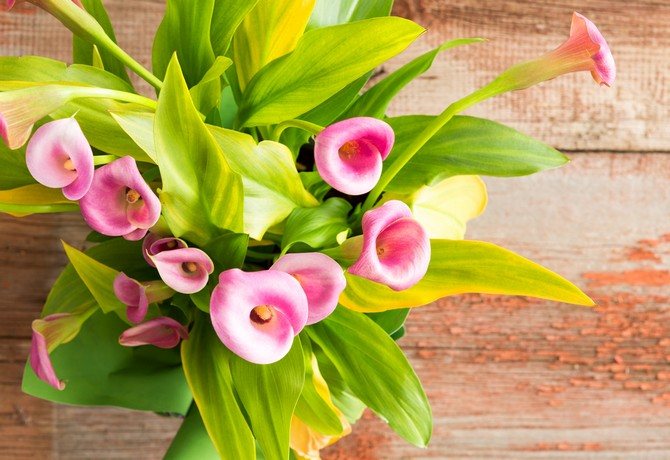

Elliot
m - and it is not characterized by a root system, but by the presence of a bulb. It is this perennial that is distinguished by its love for a humid climate, and its foliage amazes with its emerald color even when the flower is at rest.
Primarily,
- its height does not exceed 50 cm, and it often becomes a resident of many apartments, since this plant is convenient to grow in pots.
endowed with incredible beauty and great growth - up to 90 cm.
, in turn, has arrow-shaped rich malachite leaves and reaches a height of up to 150 cm.
And one more
considered home
- can be 1 m in height, has beautiful heart-shaped leaves.
As for this type of indoor calla flower, like
, then it is, first of all, a short perennial - no more than 70 cm - with an unusual pinkish-burgundy veil and narrow emerald leaves.
Evening - a specimen with characteristic black-purple inflorescences
Chameleon is a small plant that is quite often grown in pots, but also occasionally bred in the garden, with beautiful golden peach petals,
Indian summer is a perennial, characterized by scarlet-red buds.
And Garnet Glow is distinguished by its small size - up to 50 cm - and large pomegranate inflorescences.
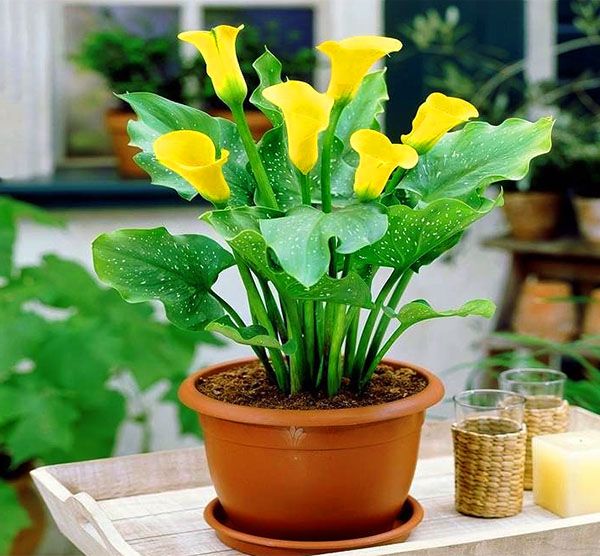

The Crystal Blush variety is even smaller: its height is about 45 cm, and the bedspread tends to change color from a snow-white shade to pinkish.
this specimen has almost black flowers, inside of which a dark red flame "blazes", like the Vorontsov lighthouse in the night.
The third species known among home gardeners is
, characterized by heart-shaped leaves and a yellowish-light green bedspread. Its dimensions do not exceed 50 cm, but it was thanks to him that many incredible beauty varieties were born.
One of them -
, which has like a marble color - white and black in combination with a cherry-lilac core and rich green leaves with white splashes.
Yellow corner with canary shade bedspread
striking with spotted foliage and creamy lemon color.
They are characterized by such features as the tuberous underground part and the presence of a dormant period - that is, they must shed their leaves. Also, it is precisely the question of how
colored calla lilies at home is considered the most relevant: experts say that they should be kept in a cool room until spring.
Amethyst
Majestic Red
Red Sox
The second perennial -
- has rich green leaves with white blotches and an unusual creamy pink bedspread.
And here
it is distinguished by a slightly bent plant, painted in scarlet undertones, and foliage with white lines.
some 40 cm in height, but its soft peach color captivates at first sight. By the way, Picasso is not inferior to him in beauty: the lavender shade of the base imperceptibly merges with the violet-beige edging.
Selina has a miniature size - 45 in height - and pointed leaves in combination with a yellow-orange color,
The Schwarzwalder surprises with its maroon color and slightly curved bedspread.
By the way, he won the love of many gardeners and
- a flower that does not exceed a height of more than 45 cm, has small leaves, and its color range combines pink and canary shades.
The white-spotted variety is characterized by pointed leaves and pink or yellowish inflorescences.
Joyful - creamy yellowish color
Powerful - lilac-violet shades.
Depending on what kind of zantedeschia the gardener wants to see on his windowsill, he can easily pick up a calla of any color and size thanks to the existing varieties.
Phytolacca berries are edible only after they are fully ripe. But in this case, the daily intake is only 5 berries for an adult and 3 berries for a child. All other parts of the plant are saturated with natural poisons and can have undesirable effects on health. Currently, 17 species of phytolacca are known, which are subdivided by genera.
The name was not given by chance, the fact is that the berries contain a specific burgundy juice inside, resembling varnish in appearance. Phytolaccaceae - literally translated from Latin as varnish plant. Extreme care should be taken when growing. If the family has small children, then it is better to refuse such a bush.
Top dressing
Fertilizers begin to be applied when the first leaves appear. Combine both root and foliar feeding. Mineral and organic fertilizers are used on average 2 times a month. Initially, at the stage of plant development, these are mainly nitrogen fertilizers. During the flowering period, more phosphorus and potassium are needed. You can use the usual complex containing these elements. Long-term and more beautiful flowering depends on them to a greater extent. Calla Ethiopian with its appearance signals a lack of a particular nutrient. With a lack of nitrogen, the leaves grow dull, losing their gloss. The lack of potassium is expressed in raising their pointed tips upwards.
When performing leaf feeding, it is very important that droplets of the solution do not fall on the white cover of the flower. This can lead to the loss of its decorative effect. By periodically replacing the top layer of the substrate, you can do without replanting the plant. At a time when Ethiopian calla is blooming, home care also allows the introduction of dressings in the form of tea leaves, egg shells, and fruit peels.
Types and varieties of zantedeschia
There are two more types of calla lilies:
- Elliott - the main feature is the yellow color of the bracts;
- Reman - is pink.
Varieties derived from different species do not have the same underground part.A branched rhizome in plants, the basis of which was Ethiopian calla, but underground compaction - tubers - in the descendants of Elliot.
The most famous varieties of zantedeschia white:
- Nicolai - peduncle, size one and a half meters. The bedspread is green from the bottom outside;
- Pearls are a variety that does not grow high, the maximum is half a meter. Suitable for breeding in flowerpots;
- Schone Zweibruckerin - peduncle up to 1 m, the leaves are light, the bottom is dark green;
- Green Goddess - stunning, gorgeous in their beauty calla lilies, grow up to 90 cm.
Division of zantedechia
Once every 3-4 years, zantedechia, which have a tuberous rhizome, are divided. This is necessary both for the reproduction of plants and for the plants to bloom annually. Tubers can be gently broken by hand or cut. Each separated part must have at least one kidney. Fresh wounds are sprinkled with crushed coal or treated with a raspberry solution of potassium permanganate.
Then they are dried for 3-4 days on the windowsill. Only after that they are planted, but watered exclusively into the pallet. After the first shoots appear, they are watered in the usual way and sprayed. Divided plants with one bud will bloom not earlier than in 1-1.5 years. Fertilizing with complex fertilizer is mandatory.
Common diseases
Zantedeskia is often affected by fungal diseases. Weakened plants that do not receive proper care are most susceptible to diseases. The signs of diseases, their names and methods of treatment are described in detail in the table.
Table - Diseases of zantedeschia
| Name and cause of the disease | Typical symptoms | Treatment methods |
| Gray rot (fungus) | - The appearance of a dirty gray bloom on the leaves; - staining the bedspread in green or brown; - withering of zantedeschia | - Pruning diseased leaves and peduncles; - treatment with fungicides "Fundazol", "Rovral"; - transplant into sterile soil; - regular ventilation of the room |
| Anthracnose (fungus) | - The appearance of small, slightly depressed spots; - an increase in the size of the spots, the formation of a red edging around them; - drying of leaves, the appearance of cracks on them; | - Removal of damaged leaves; - treatment with systemic fungicides |
| Root rot (fungus) | - Withering, drying of leaves, peduncles; - rotting of tubers and roots; - plant death | - Transplant into sterile soil with the removal of damaged areas; - reduction of watering; - treatment with fungicide "Previkur", "Profit-gold" |
| Bacterial rot (bacteria) | - Darkening of peduncles, petioles, rhizomes; - the appearance of wet rot; - yellowing of leaves | - Cutting out areas of rot, transplanting the plant into a dry sterile substrate; - treatment with fungicides (usually it is not possible to save the plant) |
| Yellow spot (virus) | - Deformation of flowers; - curling of leaves; - the appearance of light ring spots | - Extermination of insects (the virus is carried by thrips) |
Dormant period
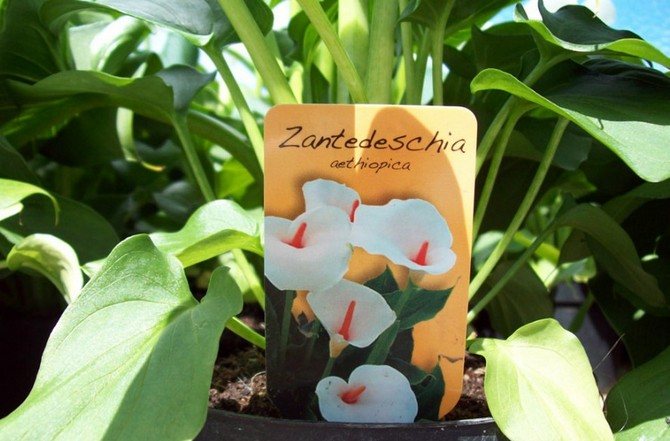

When the plant sheds its last flowers, the frequency of watering should be drastically reduced. When the flowers completely fall off, stop it altogether. In the second half of July, you need to get the plant out of the pot, shake it out, and get rid of the calla itself from the leaves by cutting them off.
After such procedures, the zantedeschia can be planted again in the pot, and the pot can be put back on the windowsill, but at the same time maintain a fairly low temperature - up to +10 degrees. At first, watering is required rather scanty, but after half a month it can be increased to abundant. In the middle of autumn, you need to slightly increase the temperature, up to about +15 degrees.
Zantedeschia transplant
Zantedeschia requires an annual transplant, since during the growing season, the plant drains the soil. This process will not cause difficulties for both experienced and novice florists.
Subtleties of transplant
- Home calla lilies absolutely do not tolerate cramped conditions, so prepare a new and spacious pot for it before transplanting.
- The bottom of the pot should always be sprinkled with a thick layer of drainage mixture (it should be at least five centimeters).For these purposes, you can use ceramic shards, large expanded clay, pebbles, crushed brick or gravel.
- A nutritious substrate for planting and replanting Zantedesia can be obtained from a flower shop or gardening department. You can also cook it yourself, for this you will need: one kilogram of fertile turf, five hundred grams of peat, five hundred grams of compost or humus, five hundred grams of leafy soil and five hundred grams of river sand. The sand should be thoroughly rinsed and calcined before use. Such a composition will help to get the land as similar as possible to the soil in which calla lilies grow in their homeland.
Preparing for transplant
- The transplant of zantedeschia should be started after the end of the flowering period in June-July. To do this, reduce the number of waterings and stop fertilizing the plant. When the foliage begins to fall, remove the calla along with the earthy clod and transplant it into fresh soil.
- Some varieties of this tropical guest do not retire or shed their leaves. They should be replanted in the spring, completely replacing the old soil with fresh soil. This procedure is necessary for the plant, since during the previous vegetative period it managed to draw out the entire nutrient reserve of the soil.
- During transplantation, you can turn one plant into several, simply by separating the young from the adult tuber.
- Some varieties go into a dormant phase and shed all their foliage completely. To transplant such plants, you need to dig out the tubers from the old soil, rinse them with warm clean water and put them in the refrigerator. In the spring, they will need to be removed from the refrigerator and transplanted into a new pot with fresh nutrient soil. If, while the tubers were in storage, they have slightly dried out or their skin is covered with irregularities and wrinkles, do not worry. Just sprinkle them with warm water and start transplanting.
- Many experienced growers who do not like to bother with soil preparation and transplanting use a hydroponic plant to grow zantedeschia at home. If you have all the necessary knowledge of the operation of this equipment, you can use it.
Transplanting the zantedeschia into a new pot
- Since zantedeschia does not like tight containers, prepare a large and spacious pot for her.
- Prepare fresh nutrient soil by mixing fertile turf, compost or humus, sand and leafy soil.
- Cover the bottom of the pot with a 5 cm layer of drainage mixture. For these purposes, you can use ceramic shards, broken brick, expanded clay and pebbles.
- Pour fresh soil onto the drainage layer, place the plant tubers in it and tamp well.
- Water the plant with warm water.
Types of homemade zantedeschia with photos and names
Ethiopian Zantedeschia (Zantedeschia aethiopica)


This variety is unpretentious, has larger flowers compared to other calla lilies. Differs in dazzling snow-white bedspread and bright yellow inflorescence-cob. The plant is up to 100 cm high, the size of the bedspread is up to 25.
Zantedeschia odorous (Zantedeschia odorata)
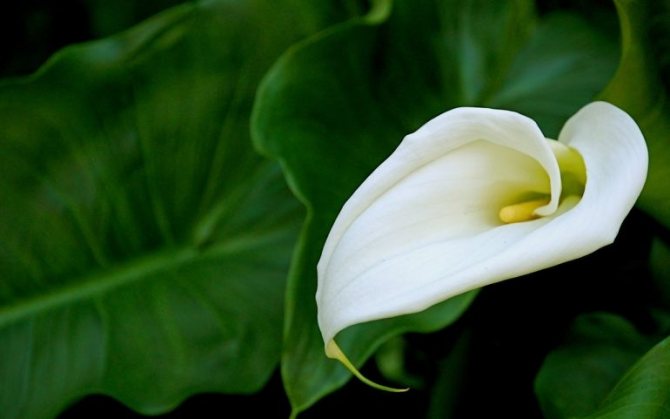

Fragrant calla is also called fragrant. Outwardly, it resembles - Ethiopian. But unlike her, it has a fragrant aroma of lily of the valley. This is a rare variety of calla lilies.
Zantedeschia elliottiana
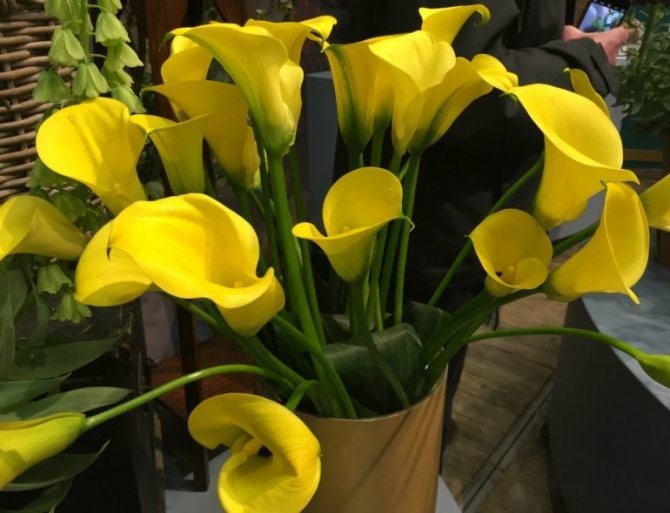

The flowers of this calla are only 16 cm high. But flower growers love it for its beautiful, bright yellow cover. The green leaves are speckled white. The variety is named after the American botanist Stephen Elliot.
Zantedeschia rehmannii
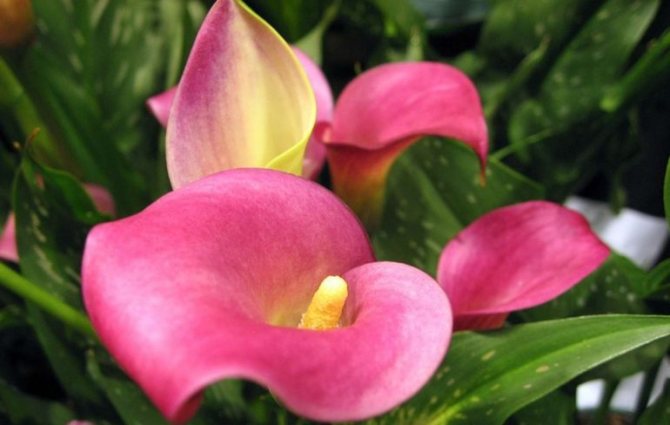

The height of this hybrid is 40-50 cm. It has elongated, long leaves, unlike other calla lilies. The width of the leaf is no more than 5 cm. The cover of the flower is light pink. The inflorescence is bright yellow.
Useful properties of zantedeschia
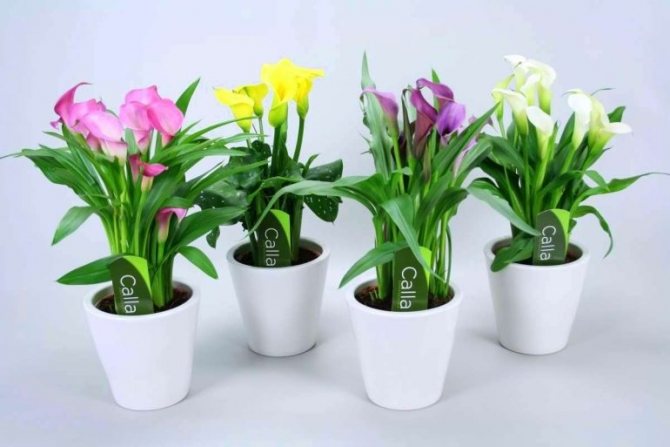

Zantedeschia (calla). Photo
Calla is one of the folk remedies for diseases. It has analgesic properties and is used to treat poisonous snake bites.
Without treatment, the plant is poisonous, but with heat exposure and drying, toxic substances in it evaporate.A decoction or tincture of crushed rhizomes helps with dropsy. Calla leaves cooked in milk are used to treat osteomyelitis.
Zantedeskia care
With proper care, the plants bloom from October to March, in December-January - especially abundantly. Summer dormancy begins in May. Then the plants are watered no more than once a week and are not fed. The greenhouse is actively ventilated and shaded from the sun. The rest period for zantedechia can be different, the minimum is within one month.
They begin to feed, abundantly spray and water the plants from late August to early September. At this time, normally developed leaves open and young roots grow. These processes are active at low temperatures: 12 ° C at night, 12-16 ° C during the day. In winter, the plants are kept cool - 12-15 ° C during the day and 16-18 ° C at night, but for 7-10 days the greenhouse can be heated to 20-25 ° C. In this "warm week" inflorescences begin to actively bloom.
Watering
In the first 2 weeks, the plant does not need strong moisture. Later, they switch to abundant watering. Water is used soft, settled. During the flowering period, additional moisture is required, so the leaves of zantedeskia are sprayed from a spray bottle, bathed in the shower. It is also necessary to ensure that water is always in the pan.
For a native of tropical Africa, the humidity in the room should be at least 55%. If this condition is met, Ethiopian calla will delight not only with large flowers, but also with beautiful greenery. Plant care involves abundant watering only during leaf development and flowering. From the moment when the rest period comes, they are reduced, then stopped altogether for 1.5-2 months and gradually renewed again. This phase in plant development usually lasts from autumn to February.
What to plant in?
You can start planting calla lilies in March. In nature, flowers grow in swampy areas, which must be taken into account when preparing the soil and choosing a flowerpot.
For one tuber, you need a pot with a capacity of at least 3 liters, and the pallet should be chosen deep enough (water must be in it constantly to create the required moisture level).
The soil for calla lilies is better to take nutritious and slightly acidic. Flowers grow well in a clay-peat mixture (1: 1) with the addition of one part of humus and half of sand.
Some growers also add a little river silt to the calla lily substrate.
Transplant and reproduction
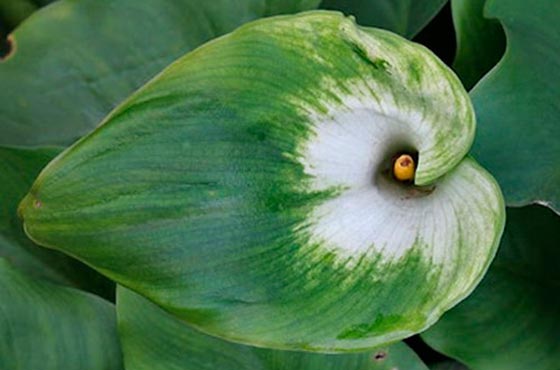

How to plant this plant? Transplant the flower annually. This is best done in July-August. For each transplant, choose a new pot based on the size of the flower bulb. Do not repot the flower in pots that are too wide. The diameter of the pot should be only a couple of centimeters larger than the diameter of the root system of this plant.
You can propagate the Ethiopian calla by dividing the bush during transplantation. At this time, carefully separate the lateral branches of the root system and plant them in small pots.
Reproduction methods
The easiest way to reproduce tuberous varieties is considered to be the separation of children during transplantation and their subsequent rooting in wet sand with the addition of peat. The mother plant itself can be rejuvenated.
To do this, the tubers are divided every two or three years. Division does not weaken the plant, but rejuvenates it, stimulates annual flowering. When dividing, they do not use cutting tools - the tubers are simply broken by hand. At the same time, they make sure that there are full-fledged kidneys on each piece. The places of the breaks must be covered with coal powder, only then they are planted.
For seed propagation, only freshly harvested seeds are used. Over time, they lose their germination. Seeds are sown in early spring in light sandy-peat soil, covered with foil. Keep warm, with good lighting. After emergence, the film is removed. The grown seedlings can be planted in separate pots. There are not very many supporters of this breeding method.In reviews, flower growers often write that plants from seeds develop slowly, bloom only in the fifth year.
If you do not plan to harvest the seeds from the zantedeschia, it is better to cut off the fading inflorescences. The right time to trim is to change the color of the bedspread to green. Seed ripening takes a lot of strength from the calla - a weakened plant may not survive the winter.
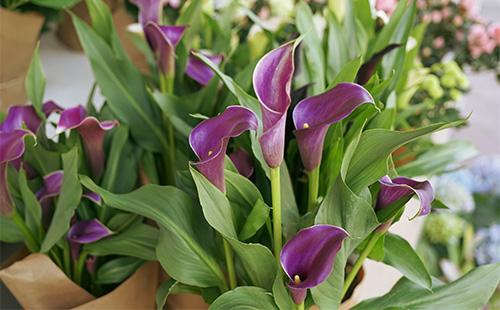

Breeding process
Rhizome division is the way zantedeschia propagates. This happens after the end of the dormant period. The shoots that appeared on the sides are separated from the mother and planted in low pots. Instructions with videos, photos can help if you are a newcomer to floriculture.


They should not be watered much so that the decay process does not occur. After the appearance of the first leaves, the amount of water should be gradually increased, at the same time starting to feed the plant with fertilizers.
Reproduction
Calla lilies are grown in three ways:
- Reproduction by tubers occurs in the spring. In the fall, after the onset of the first frost, the bulbs are carefully dug up. Wrapped in paper and placed in a cardboard box, where it is stored in the open field until disembarking.
- Reproduction by dividing the bush in the fall, the flower is dug up, the stem with the roots is separated and transplanted into a pot. With the onset of spring, the plant, along with the soil, is planted on the site.
- Seed propagation is often used by breeders, since the seeds are capricious and do not germinate well. The collected material is spread on a damp paper towel, covered with another one on top. Planting material is placed in a warm place for 7 days. During this period, it is necessary to ensure that the towel is constantly wet. If freshly harvested grains are placed in a solution of potassium humate (for six hours), germination will accelerate.
Flowering period
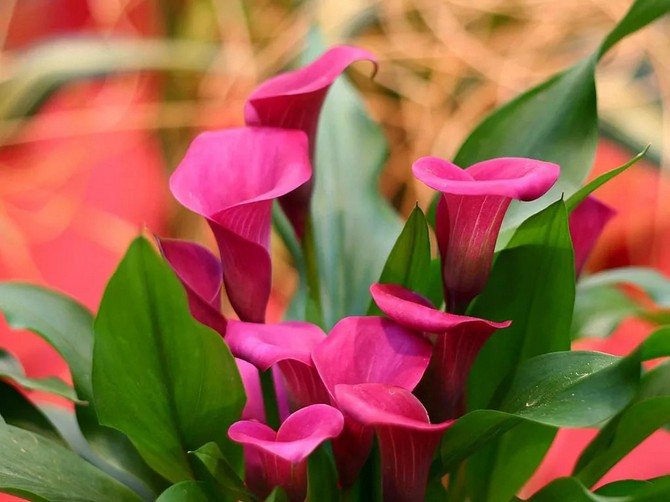

When zantedeschia is two years old, it is able to bloom. With its flowering, it will delight your eye all winter, starting in November. By changing the temperature, you can clearly predict the moment when the plant will bloom. In theory, it can bloom throughout the year, but for calla lilies it will be better if you adhere to the "regime" when it blooms in winter.
Within 2-4 years, calla lilies can bloom excellently, after which offspring grow on it, which must be regularly cut and transplanted into the renewed plant.
At the end of the flowering period, the plant may begin to turn yellow, but the roots will continue to grow despite this.
Feeding calla lilies home
During the period of active growth, from February to June, wonderful zantedeschia, which does not cause much trouble at home, needs fertilizing: mineral (Pocon, Agricola, Fertika-Lux, Bona Forte ) and organic (compost, humus, rotted manure, the preparation "Giant"). Organic matter is required for a pet for the formation of a lush bush and active growth of leaves and is carried out every one and a half to two months. Mineral preparations contain a high percentage of phosphorus and potassium, which are the key to successful flowering.
Growing zantedeschia at home
How to grow? Look after? Basic points for home care - must be followed:
- Lighting. An important factor, sunlight is needed in summer and winter. It gets used to any environment, it is not necessary to place the flowerpot on the south side in the summer - it threatens to dry out the soil.
- Temperature conditions. Calla loves warmth. For proper development, it is important to ensure the temperature is above 18 ° C, 22-25 ° C is ideal. Protect from drafts, drops.
- Humidity. Constant spraying, washing of leaves is necessary. It can grow at room humidity, if you want it to be healthy - increase the amount of moisture.
- Watering. Active onset of growth - Moderate fluid intake. Spring-autumn is the time of flowering - the time of abundant watering. During the dormant period, watering should again be reduced to a moderate state. The water should be warm at room temperature.
- Fertilizer.In the hour of growth and flowering, the flower needs fertilizing with fertilizers created for flowering plants, with the help of nitrogen means, you will simply improve the growth of the leaves.
- Transfer. The pot in which you are going to plant the calla lilies should be large and spacious. It is imperative to have drainage so that the water does not stagnate and the rhizome does not rot. The transplant should be done regularly once a year. The tuber should be about 5-10 cm in the ground. If you are going to buy it from the store, it may be difficult to determine the bottom-top. To do this, moisten it in a growth stimulant, place it in a dark, humid place for several days - so you can see where the stem is growing from.
- Rest period. Time after the active flowering phase. It is characterized by the fact that the part of the plant that is above the ground dries up. It is important to reduce watering, or almost stop. Removing dry leaves, transplanting into new soil occurs in the middle of summer. A month and a half is a good period for rest.
- The soil. Regular soil is not suitable for growing calla lilies at home. For proper care, you need to buy a store special substrate created for plants of the Aroid family. You can do it yourself. In short, you need turf, leaf, peat, humus earth, sand.
Ground requirements
Calla lilies naturally prefer wet, marshy areas. This must be taken into account when preparing the soil mixture for planting, adding river silt to it and placing a deep pan under the pot (it must contain a layer of water of at least 5 cm). If you are counting on a perennial plant, it is necessary that the substrate is slightly acidic, rich in nutrients. It should contain clay-sod and peat soil, humus, sand (all in a ratio of 1: 1: 1: 0.5). It is very good if there is an opportunity to add a little marsh substrate or river silt. Ethiopian homemade calla grows well in clean peat. Some growers use manure or compost to prepare the soil mixture.


Zantedeschia hybrids
Memories
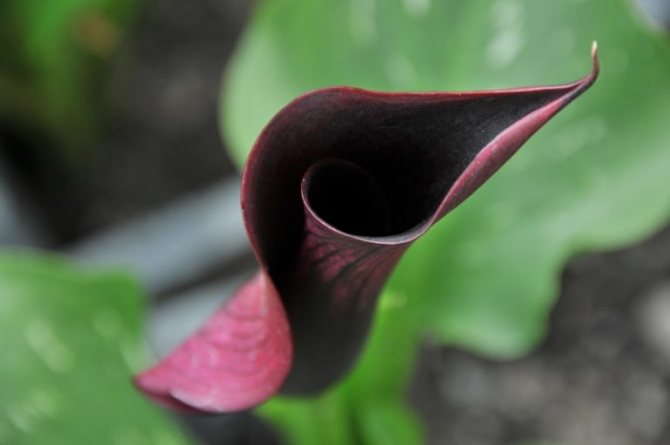

The color of the coverlet of this calla is unusual, black with a burgundy tint, up to 12 cm in size. The inflorescence is the same, black and burgundy, like the coverlet. Plant height - from 45 to 50 cm.
Nashville (Nashville)
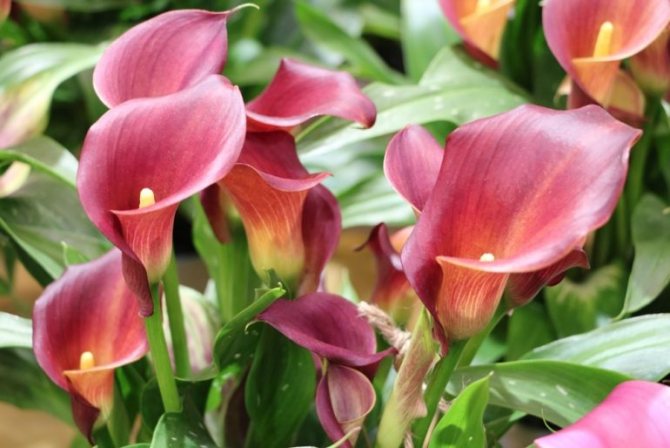

The shape of the perianth of this calla is elongated and narrowed, the color is two-tone: white-pink. The inflorescence is bright yellow. The size of the bedspread is 12 cm. The plant is compact, up to 45 cm high.
"Picasso"


The flower is white at the edges, with a transition to a purple neck. The height of the peduncle is up to 15 cm, the bedspread is 10 cm. The duration of flowering of one flower is up to 25 days. On dark green leaves there are white blotches, which take on a metallic hue in the sun.
Red Alert


Plant height up to 55 cm. The flower consists of a small bright red blanket and a red inflorescence. The blanket is elastic, shiny, like wax. The leaves are covered with frequent, white specks.
General rules for growing
Wherever you plant them: at home in a pot or in the country, you need to remember a few points:
- shallow planting is required, the rhizome is barely covered with soil;
- until the root system is formed, calla will not sprout, this can last about a month;
- be extremely careful when digging - tubers can be easily damaged;
- rain can be predicted by calla lilies: water droplets appear on it if bad weather is gathering;
- the pot should be porous, no other plants in the same flowerpot - cannot stand neighbors;
- sometimes the top layer needs to be carefully removed, replaced with a fresh substrate.
Main types
Both for growing in flower beds and at home, several of the most popular species are distinguished, differing not only in the structure and height of the bush itself, but also in the shade of the cover itself, which borders the peduncle. Let's take a look at some of them:
Zantedeschia Eliot
The species is distinguished by the yellow color of the sheet - bedspreads. The height and volume of the peduncle and leaves are slightly less than that of whites.In the summer, the plant begins a dormant period. The entire aerial part dies off, and the tuber is removed to a dark place.
This flower is characterized by small dense leaves, glossy, with small light blotches. The flower itself is a bright lemon shade with a sharp top.


Zantedeskia Remann
The shade of the flower varies from pale pink to rich crimson, almost red.
- A distinctive feature of the species is the structure of the leaf: it is not arrow-shaped, like in other species, but half-straight, the corners are slightly bent, and small stains of a lighter tone are located along the entire plane of the leaf plate.
- Flowering begins from mid-July to early September. The core is shorter than that of other species, only 7 cm. The height of the shoot itself, together with the flower, is no more than half a meter.
These 2 species have served breeders to breed colored calla lilies. The range of colors is very rich: from almost black with a purple tint to delicate pink, and then red and orange tones. You can choose any shade depending on any design solution.
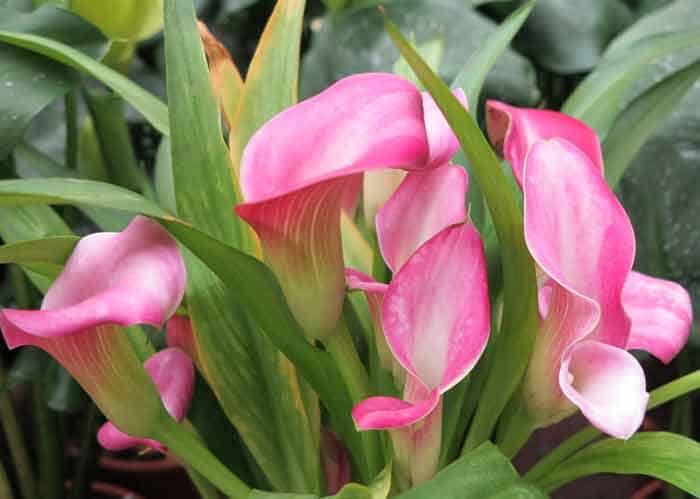

Botanical description
Tuberous perennial plant. In addition to swamps, it is found on the coasts of warm and humid tropical forests. The rhizome is branched, powerful, completely submerged in water. Strong erect shoots depart from the rhizome. Leaves on high petioles, large, cordate. The color is more often uniformly green, sometimes with an admixture of white or light shades of cream.
The inflorescence is an ear, wrapped in a blanket of different colors. There are varieties with purple, white, red, yellow, cream bedspreads. Sometimes two colors are harmoniously combined in coloring. It is not a bright contrast that is characteristic, but a smooth transition of tones. The inner side is usually slightly lighter in color. It blooms for a long time - from spring to autumn.
The first step to success in growing is to transplant the zantedeschia after purchase. Calla lilies are usually sold in small containers and standard shipping media. When transplanting, use a larger pot, balanced nutritious, slightly acidic soil.
How to choose a plant in the store


The right purchase is, first of all, the acquisition of an exceptionally healthy plant pet. Opt for a zantedeschia with symmetrical stems and ears. Examine them from all angles for pests or any other signs of disease. The soil should not be overdried or with stagnant water. Compliance with the rules for caring for the store is a guarantee of the future health and growth of a representative of the flora. It is better to please yourself with a new plant before it blooms (if you decide to have an adult specimen). According to the recommendations of experienced florists, it is better to start acquaintance with calla lilies with young plants.
Transfer
Soil replacement is an effective way to replace depleted soil after the growing season. It is held once a year. When changing the "place of residence" calla lilies should not be deepened excessively. And in the new tub, the soil level is left the same. Otherwise, it leads to rotting. If for some reason it is impossible to completely replace the soil (there is damage, weakening after an illness), then only the upper layer is dispensed with.
Only single disembarkation is allowed. Neighborhoods in one container are not tolerated by the Aroids. The transplant is carried out very carefully so as not to break the roots. The process ends with watering.
Landing
In March, spacious pots are prepared - for 1 tuber, the capacity should be at least 3 liters. A soil mixture is poured into them with the addition of superphosphate to it (1 tablespoon for every 3 liters of substrate). A drainage layer must be poured at the bottom.
Tubers to be planted must be healthy. This is evidenced by their elasticity, light yellow color and the presence of live apical buds. Overdried gray tubers with wrinkled skin are not suitable. Existing areas of rot or growths are carefully scraped off with a sharp knife.
Before landing, some preparatory work is carried out.For 2-3 weeks, the tubers are transferred to a warm place with good lighting. Then it is dipped for 15 minutes in a weak solution of potassium permanganate, and then dried. This will help protect the flowers from decay and pest damage, from which Ethiopian calla often suffers.
The tubers are planted shallowly - by a maximum of 10 cm - and slightly moistened. The pots are placed where it is warm and there are no drafts.
Some general information
Ethiopian calla (calla aethiopica) or as it is also called Ethiopian zantedeschia (zantedeschia aethiopica) is found in the marshes of southern Africa. This is the most optimal and comfortable environment for growth.
On average, Ethiopian calla grows up to one meter at home. The sheets are quite long, up to 50 centimeters, similar to narrow plates, up to 20 centimeters wide. They grow from the root by gathering in rosettes. There is a flower on a thick root, from which an inflorescence of an ear can be seen. Flowering begins in February and lasts only about a month.
Breeding calla lilies at home is not difficult. a series of rules should be followed, and decent care should be provided. This applies to both garden flowers and indoor flowers. They have their own needs and characteristics:
- It should be planted shallowly so that the root system is only slightly covered with soil. Otherwise, putrefactive processes may begin.
- What novice flower growers call a flower, in nature is a cover leaf, which is also called a veil, it wraps an ear of an inflorescence. In reality, calla flowers are very tiny, but they emit a wonderful aroma.
- The flower after planting will not rise until its rhizome is fully formed. In this case, do not be discouraged if you do not see sprouts for a long time.
- Dig up the tubers of the flower very carefully so as not to damage it.
- For Ethiopian calla, it is recommended to choose porous pots. Thus, unnecessary moisture will evaporate, leaving it easier.
- Calla is a loner flower, she does not like the presence of neighbors nearby.
- Periodically, the top layer of soil in the pot should be removed, carefully, without touching the roots. A little nutrient soil is poured on top.


